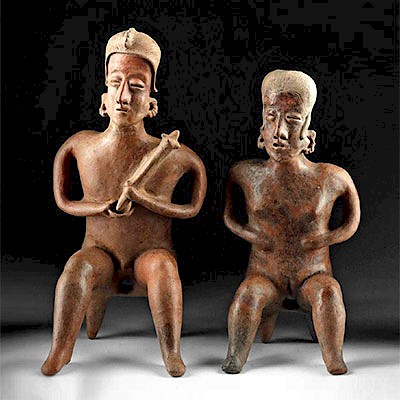Large / Rare Chavin Painted Cotton Textile
Lot 121b
About Seller
Artemis Gallery
686 S Taylor Ave, Ste 106
Louisville, CO 80027
United States
Selling antiquities, ancient and ethnographic art online since 1993, Artemis Gallery specializes in Classical Antiquities (Egyptian, Greek, Roman, Near Eastern), Asian, Pre-Columbian, African / Tribal / Oceanographic art. Our extensive inventory includes pottery, stone, metal, wood, glass and textil...Read more
Estimate:
$12,000 - $15,000
Absentee vs Live bid
Two ways to bid:
- Leave a max absentee bid and the platform will bid on your behalf up to your maximum bid during the live auction.
- Bid live during the auction and your bids will be submitted real-time to the auctioneer.
Bid Increments
| Price | Bid Increment |
|---|---|
| $0 | $25 |
| $300 | $50 |
| $1,000 | $100 |
| $2,000 | $250 |
| $5,000 | $500 |
| $10,000 | $1,000 |
| $20,000 | $2,500 |
| $50,000 | $5,000 |
| $100,000 | $10,000 |
| $200,000 | $20,000 |
About Auction
By Artemis Gallery
May 23, 2019
Set Reminder
2019-05-23 10:00:00
2019-05-23 10:00:00
America/New_York
Bidsquare
Bidsquare : Exceptional Day 2 Ethnographic Tribal Fossils
https://www.bidsquare.com/auctions/artemis-gallery/exceptional-day-2-ethnographic-tribal-fossils-4136
Day 2 of an important 2-day auction featuring exceptional ethnographic art from around the world. Today's sale will feature Pre-Columbian from the ancient americas, Native American, African / Tribal, Oceanic, Spanish Colonial, and incredible Fossils. Artemis Gallery info@artemisgallery.com
Day 2 of an important 2-day auction featuring exceptional ethnographic art from around the world. Today's sale will feature Pre-Columbian from the ancient americas, Native American, African / Tribal, Oceanic, Spanish Colonial, and incredible Fossils. Artemis Gallery info@artemisgallery.com
- Lot Description
Pre-Columbian, South Coast Peru, Chavin-Karwar, ca. 4th to 3rd century BCE. A cotton based textile fragment from the North Coast of Peru, but purportedly found in South Coast Peru. The tightly woven fabric is decorated with curvilinear and linear motifs as well as zoomorphic, camelid forms of refined iron-rich pigments. As a wearable and portable artform in which complex imagery was featured, textiles spread Chavin iconography from the northern coast, where it originated, to the south, where this fragment was purportedly found. Even more fascinating, the painting style and visual motifs resemble those of stone carvings at Chavin de Huantar. Size: 25" W x 25.25" H (63.5 cm x 64.1 cm); 30.625" W x 30.75" H (77.8 cm x 78.1 cm) with mat and lucite framing
Andean textile art began as early as the third millennium BCE and continued to be a medium of artistic expression as well as a medium used for communicating cultural information - religious, social, and political - for thousands of years. Interestingly, in Peru fabric art preceded ceramics by more than a thousand years. Sometimes designs were woven into the fabric, sometimes they were embroidered, and sometimes, as we see in this example, they were painted onto the fabric.
The Chavin people lived in the northern Highland Andes, and their capital, Chavin de Huantar, is an UNESCO World Heritage Site. The artwork of Chavin represents the first widespread style in the Andes. The center of Chavin de Huantar is a massive, flat-topped pyramid, surrounded by lower platforms. Between 1200 and 500 BCE the pyramid space was used for religious ceremonies. The Old Temple, constructed very early in the history of the site, consists of a series of passageways built around a circular courtyard; within were carved stone monuments showing jaguars, serpents, and other figures with transformative and/or anthropomorphic figures.
For a similar example in the collection of the Metropolitan Museum of Art, please see https://www.metmuseum.org/art/collection/search/315784
Provenance: private Hawaii, USA collection
All items legal to buy/sell under U.S. Statute covering cultural patrimony Code 2600, CHAPTER 14, and are guaranteed to be as described or your money back.
A Certificate of Authenticity will accompany all winning bids.
We ship worldwide and handle all shipping in-house for your convenience.
#136650Losses to peripheries and a few areas of loss and/or loose weaving to the interior of the composition. Normal fading to pigments.Condition
- Shipping Info
-
All shipping is handled in-house for your convenience. Your invoice from Artemis Gallery will include shipping calculation instructions. If in doubt, please inquire BEFORE bidding for estimated shipping costs for individual items.
-
- Buyer's Premium



 EUR
EUR CAD
CAD AUD
AUD GBP
GBP MXN
MXN HKD
HKD CNY
CNY MYR
MYR SEK
SEK SGD
SGD CHF
CHF THB
THB













